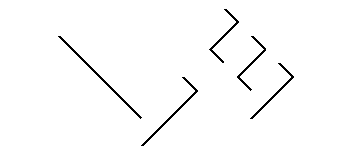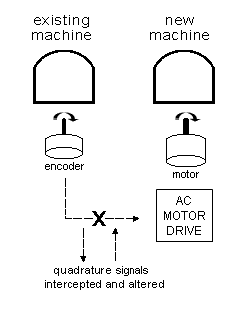LAUGHTON ELECTRONICS |
|
Motor Synchronization: Lying to the machine, Case study #1 |
|
 |
This story describes a scheme to elicit a certain desired behavior from an electronic drive for a three-phase motor. |
  |
A client of mine was developing a machine they hoped to market to the printing industry. The new machine was an accessory for a printing press, and it was required to match the speed of the press and to rotate exactly in sync just as if a drive shaft linked the two together. But the drive shaft was to be virtual, not mechanical. An encoder would attach to the printing press, and a separate motor, cued by the encoder, would power the accessory. The client had most of the system already in place, including the encoder and a three-phase motor and electronic drive from a well known manufacturer. What was missing was a certain setup adjustment. What was needed was a means by which to initially bring the accessory into register with the press. In other words, during setup procedures the machine operator would need to add or subtract as much a one-half revolution in order to set the timing — the relative positions, or phase angle — between the press and the accessory. (A swivel mount to skew the position of the encoder chassis would've done the trick, but the client didn't want to go that route.) "lying" to the machineOur approach was to introduce a temporary deviation in the sync between the press/encoder and the electronic drive/motor system. We wanted the latter to run minutely faster or slower than the press until the desired relation was achieved. I produced the controlled deviation by intercepting and falsifying the signals from the encoder to the drive. The hardware investment was minimal — just a little circuit board, whose main component was a Motorola 68HC705 single chip microcomputer. The program, written in assembler, had an inner loop that was short but sweet. It input the quadrature pulse train from the encoder and tracked the four possible states of the two input signals. Then it synthesized a quadrature output. The two channels of the ersatz output signal were fetched from a lookup table, using a 2-bit index derived from the current input state plus a value representing the accumulated deviation. |
|
|
 |
|